gps
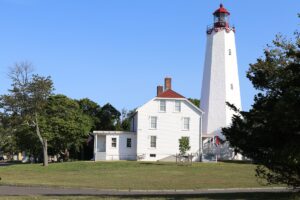 A lighthouse is by definition, a tall building set on the coast with a light in its tower to warn ships of the presence of dangerous rocks or shores. I have long loved lighthouses…their history, the ships they protected, and the place you find them. These days, there might not be as much need for lighthouses, because of GPS, but GPS can fail, computers can crash, and some solar activity can affect GPS too. There are lots of reasons why it can fail, so these days, lighthouses might be considered a…backup plan. You never know when they might be needed, and that is not the time to find out that you don’t have them.
A lighthouse is by definition, a tall building set on the coast with a light in its tower to warn ships of the presence of dangerous rocks or shores. I have long loved lighthouses…their history, the ships they protected, and the place you find them. These days, there might not be as much need for lighthouses, because of GPS, but GPS can fail, computers can crash, and some solar activity can affect GPS too. There are lots of reasons why it can fail, so these days, lighthouses might be considered a…backup plan. You never know when they might be needed, and that is not the time to find out that you don’t have them.
The lighthouse at Sandy Hook, in what is now New Jersey, was put in use on June 11, 1764. It was needed badly, and the Provincial Congress of New York orchestrated two lotteries to raise money for its construction. As with many projects, things moved slowly. The lighthouse was first suggested for Sandy Hook nearly a century before, but it was finally initiated by Colonial Governor Edmund Andros. It finally became a priority 43 New York merchants, lost 20,000 pounds of sterling from shipwrecks in  early 1761. Suddenly, it was really important. to protect those ships and their cargo. In the 27 months that the light house at Sandy hook stood, she had protected many ships.
early 1761. Suddenly, it was really important. to protect those ships and their cargo. In the 27 months that the light house at Sandy hook stood, she had protected many ships.
Then, on March 6, 1776, a committee of the New York Provincial Congress instructs Major William Malcolm to dismantle the Sandy Hook lighthouse. The territory was in dispute, and Major Malcolm’s task was to prevent the lighthouse from helping the British to reach New York City. The Congress wanted Malcolm to remove the lens and lamps so that the lighthouse could no longer warn ships of the rocky shore. Major Malcolm succeeded. Colonel George Taylor reported six days later that Malcolm had “given him eight copper lamps, two tackle falls and blocks, and three casks, and a part of a cast of oil from the dismantling of the beacon.” While the removal would most certainly mean the loss of ships and lives, it was deemed collateral damage, even if some of the ships were friendlies.
While the lighthouse removal was a success, it did not keep the British from invading New York. They were soon 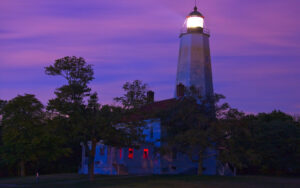 able to put the lighthouse back into service by installing lamps and reflectors. The Patriots attempted to knock the light out again on June 1, 1776, by placing cannon on boats and attempting to blow away the British equipment. They managed some damage before being chased away. The new states of New Jersey and New York bickered over ownership of the lighthouse, until the federal government assumed control of all US lighthouses in 1787. As of 1996, the Sandy Hook lighthouse, the oldest original lighthouse in the United States, passed into the jurisdiction of the National Park Service. I’m glad it survived all that turmoil. It would be sad if it was lost forever.
able to put the lighthouse back into service by installing lamps and reflectors. The Patriots attempted to knock the light out again on June 1, 1776, by placing cannon on boats and attempting to blow away the British equipment. They managed some damage before being chased away. The new states of New Jersey and New York bickered over ownership of the lighthouse, until the federal government assumed control of all US lighthouses in 1787. As of 1996, the Sandy Hook lighthouse, the oldest original lighthouse in the United States, passed into the jurisdiction of the National Park Service. I’m glad it survived all that turmoil. It would be sad if it was lost forever.
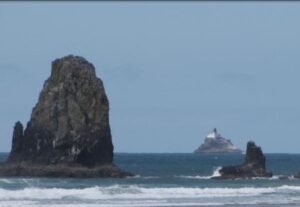 “Terrible Tilly” came by her name honesty, because from the start, the lighthouse seemed to be nothing but trouble. “Terrible Tilly” is the nickname of the Tillamook Lighthouse sits on top of a sea stack of basalt, more than a mile off the banks of Oregon’s North Coast. Looking to put up a lighthouse in the area Tilly’s story began in 1878 when a solid basalt rock was selected as the location for a lighthouse off the coast of Tillamook Head. Any construction work can have its dangers, but construction a mile offshore in all kinds of weather, can be particularly dangerous. Such was the case with “Terrible Tilly” when even before the work began, a master mason surveying the location was swept out to sea, never to be seen again.
“Terrible Tilly” came by her name honesty, because from the start, the lighthouse seemed to be nothing but trouble. “Terrible Tilly” is the nickname of the Tillamook Lighthouse sits on top of a sea stack of basalt, more than a mile off the banks of Oregon’s North Coast. Looking to put up a lighthouse in the area Tilly’s story began in 1878 when a solid basalt rock was selected as the location for a lighthouse off the coast of Tillamook Head. Any construction work can have its dangers, but construction a mile offshore in all kinds of weather, can be particularly dangerous. Such was the case with “Terrible Tilly” when even before the work began, a master mason surveying the location was swept out to sea, never to be seen again.
Even with the dangers and the loss, work began in 1880, and the lighthouse went into operation in 1881. In those days…the days before GPS, lighthouses were a vital part of the shipping business. The ships couldn’t see the 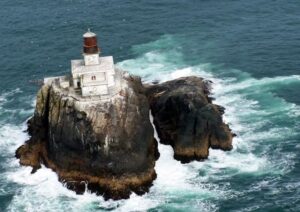 dangers that lurked in the night, so knowing what was just below the surface, or even above the surface of the water was very important. As ships got closer to shore, the possibility of hitting rock or small island could be disastrous. Never was that more evident that the disaster that occurred just a few weeks before the lighthouse opened. A ship sailed too close to the shore because of low visibility, and crashed, killing all 16 crew members. The need for the lighthouse was proven once again, in a very sad way.
dangers that lurked in the night, so knowing what was just below the surface, or even above the surface of the water was very important. As ships got closer to shore, the possibility of hitting rock or small island could be disastrous. Never was that more evident that the disaster that occurred just a few weeks before the lighthouse opened. A ship sailed too close to the shore because of low visibility, and crashed, killing all 16 crew members. The need for the lighthouse was proven once again, in a very sad way.
While you might think that making the lighthouse operation would have ended the tragic connections with “Terrible Tilly,” but that really wasn’t the case. The conditions on the lighthouse were extremely rough, and one lighthouse keeper even allegedly went insane. Being even just a mile offshore, made life very isolated. The storms beat on the lighthouse, and I’m sure they sometimes wondered if the lighthouse could take it. The howling wind can be enough to drive some people crazy. Living in Wyoming, I know that there are times when 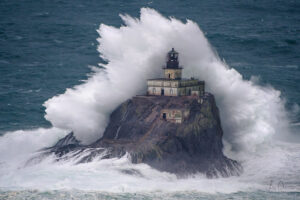 we wonder if the wind will ever quit. When it finally does, it is almost shockingly quiet. Not everyone can take the howling wind.
we wonder if the wind will ever quit. When it finally does, it is almost shockingly quiet. Not everyone can take the howling wind.
As GPS came into being, the need for lighthouses is becoming less and less. It’s rather a sad fact, because these icons of history, are fading into the past, and for me, that feels very sad. Decades after the lighthouse was decommissioned in 1957, it was turned into a columbarium, which is a storehouse for urns of cremated remains. To this day, the remains of 30 people are still stored inside the lighthouse. “Terrible Tilly” was closed down in 1957 and remains off limits to the public to this day.
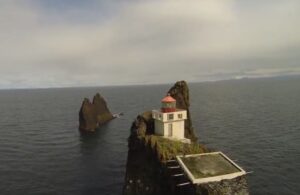
 In the years before GPS (Global Positioning System), lighthouses were a vital part of keeping ships off of the shore, rocks just below the surface, and islands. While necessary, lighthouses were not always easy to build. Of course, a lighthouse that sat on the shoreline of a coast was a fairly simple build, but one that sat on the top of a dangerous rock outcropping was more difficult, especially if the rocks were very tall and hard to access, like the Pridrangaviti Lighthouse in the Westman Islands of Iceland.
In the years before GPS (Global Positioning System), lighthouses were a vital part of keeping ships off of the shore, rocks just below the surface, and islands. While necessary, lighthouses were not always easy to build. Of course, a lighthouse that sat on the shoreline of a coast was a fairly simple build, but one that sat on the top of a dangerous rock outcropping was more difficult, especially if the rocks were very tall and hard to access, like the Pridrangaviti Lighthouse in the Westman Islands of Iceland.
The Pridrangaviti Lighthouse was built in 1938, right before the onset of World War II. Its construction was by 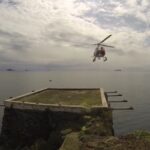 no means an easy task. Construction workers had to scale the cliff to reach the place where they were to lay the lighthouse groundwork. This mean facing slick rocks, rain, winds, and even heavy surf. One misstep would lead to their death on the rocks and icy North Atlantic Ocean below. Nevertheless, the task was eventually finished, and the effect is quite beautiful.
no means an easy task. Construction workers had to scale the cliff to reach the place where they were to lay the lighthouse groundwork. This mean facing slick rocks, rain, winds, and even heavy surf. One misstep would lead to their death on the rocks and icy North Atlantic Ocean below. Nevertheless, the task was eventually finished, and the effect is quite beautiful.
The lighthouse warns passing ships of a cluster of slender rock pillars that jut out from the ocean’s surface. The pillars look like fingers stretching toward the sky, and they are located miles away from civilization. The lighthouse looks like a colorful speck on top of the largest pillar. The tiny, red-roofed lighthouse is quite likely one of the loneliest lighthouses in the world, and I don’t think I would want to be the person who had the job of manning it. The lighthouse is the only thing on the rock, and so you would likely be there for at least a month at a time before it would be feasible to leave.
Repairs were a big issue as well…at least until modern times. These days, when repairs are needed, supplies 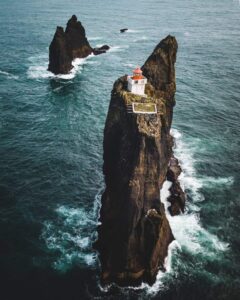
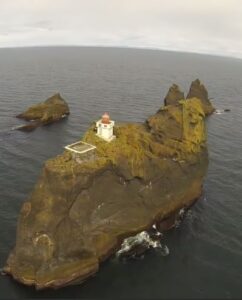 and workers can be helicoptered in. And these days, the rock sports a helicopter pad for any visitors who might go there. You could also get there by boat and go rock climbing to reach the top, but anyone who goes must know that visiting the Pridrangaviti lighthouse is a dangerous endeavor. One wrong step, and any unsuspecting explorers just may find themselves going for an unplanned swim with the killer whales that like to hang out in the waves below. Nevertheless, just imagine being able to go and visit such a lighthouse. I’m not a rock climber, so I don’t know about climbing up, but to helicopter in and be able to explore the lighthouse and the grounds…yep, that would be very cool.
and workers can be helicoptered in. And these days, the rock sports a helicopter pad for any visitors who might go there. You could also get there by boat and go rock climbing to reach the top, but anyone who goes must know that visiting the Pridrangaviti lighthouse is a dangerous endeavor. One wrong step, and any unsuspecting explorers just may find themselves going for an unplanned swim with the killer whales that like to hang out in the waves below. Nevertheless, just imagine being able to go and visit such a lighthouse. I’m not a rock climber, so I don’t know about climbing up, but to helicopter in and be able to explore the lighthouse and the grounds…yep, that would be very cool.
 There are all kinds of records, but some are just stranger than others. Switzerland actually holds a strange record…for attacking its neighbor, Liechtenstein. This is particularly odd in that Switzerland is a neutral nation…very opposed to war!! In fact, Switzerland is the longest standing neutral nation in the world and has not taken part in a “war” since 1505. Its official stance of non-involvement had been decided during The Congress of Vienna in 1815, in which major European leaders met to discuss the nature of Europe after the defeat of Napoleon. Nevertheless, they do have an army.
There are all kinds of records, but some are just stranger than others. Switzerland actually holds a strange record…for attacking its neighbor, Liechtenstein. This is particularly odd in that Switzerland is a neutral nation…very opposed to war!! In fact, Switzerland is the longest standing neutral nation in the world and has not taken part in a “war” since 1505. Its official stance of non-involvement had been decided during The Congress of Vienna in 1815, in which major European leaders met to discuss the nature of Europe after the defeat of Napoleon. Nevertheless, they do have an army.
Diplomatic and economic relations between Switzerland and Liechtenstein have been good. In fact, you could say relations were very good, with Switzerland accepting the role of safeguarding the interests of its tiny next-door neighbor. Liechtenstein has an embassy in Bern, Switzerland, and Switzerland is accredited to Liechtenstein from its Federal Department of Foreign Affairs in Bern and maintains an honorary consulate in Vaduz, Liechtenstein. The two countries also share an open border, mostly along the Rhine, but also in the Rätikon range of the Alps, between the Fläscherberg and the Naafkopf.
With all that “good will” between the nations, you would never expect conflict, but apparently, Switzerland has 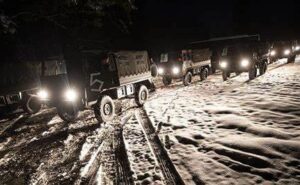 attacked Liechtenstein three times in 30 years. Of course, it was by mistake each time! How does that happen? Nevertheless, it did. The first time was probably the only “aggressive” accident of the bunch. On December 5, 1985, during an artillery exercise, the Swiss Army had launched munitions in the middle a winter storm. The wind took the munitions way off course, into the Bannwald Forest of Liechtenstein, and started a forest fire. No one was injured and the Liechtenstein government was very angry. Switzerland had to pay a heavy penalty for the environmental damage caused. The second attack took place on October 13, 1992. The Swiss Army received orders to set up an observation post in Treisenberg. They followed the orders and marched to Treisenberg. What they didn’t realize was that Treisenberg lies within the territory of Liechtenstein. They marched into Treisenberg with rifles and only later realized that they were in Liechtenstein. The last attack was on March 1, 2007. A group of Swiss Army infantry soldiers was in training when the weather took a bad turn. There was heavy rainfall, and the soldiers were not carrying any GPS or compass. Eventually, they ended up in Liechtenstein! Switzerland apologized to the Liechtenstein government for the intrusion, yet again.
attacked Liechtenstein three times in 30 years. Of course, it was by mistake each time! How does that happen? Nevertheless, it did. The first time was probably the only “aggressive” accident of the bunch. On December 5, 1985, during an artillery exercise, the Swiss Army had launched munitions in the middle a winter storm. The wind took the munitions way off course, into the Bannwald Forest of Liechtenstein, and started a forest fire. No one was injured and the Liechtenstein government was very angry. Switzerland had to pay a heavy penalty for the environmental damage caused. The second attack took place on October 13, 1992. The Swiss Army received orders to set up an observation post in Treisenberg. They followed the orders and marched to Treisenberg. What they didn’t realize was that Treisenberg lies within the territory of Liechtenstein. They marched into Treisenberg with rifles and only later realized that they were in Liechtenstein. The last attack was on March 1, 2007. A group of Swiss Army infantry soldiers was in training when the weather took a bad turn. There was heavy rainfall, and the soldiers were not carrying any GPS or compass. Eventually, they ended up in Liechtenstein! Switzerland apologized to the Liechtenstein government for the intrusion, yet again.
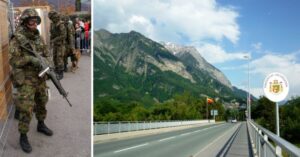
Thankfully these “accidental” attacks were not of a deadly nature. They were really more a “comedy of errors” than an attack. Thankfully, the people of Liechtenstein saw the “attacks” for what they were, and tended to care for their “intruders,” rather than fight back. Of course, that would have been difficult too, since Liechtenstein does not have an army of their own, and so depended on the “protection” of their neighbors…when they didn’t accidentally attack them.
 I like lighthouses. That is just a fact. I am particularly fascinated with unusual lighthouse. There are many lighthouses all over the world. They are, of course, used to direct ships away from shallow waters or dangerous rocks that lurk below the surface of the water. Today, there are more than 21,600 lighthouses worldwide, and there are a few that are still in use. In pre-GPS days, they played a vital role in the shipping industry, but these days they are usually used as tourist attractions. Many are privately owned, and are only used in an extreme emergency, when the electronic guidance systems are down. Some lighthouses are simply abandoned. I have mixed feelings about those, because when abandoned, they usually fall into disrepair, but there is something about abandoned buildings that has always intrigued me…even when they have fallen into disrepair.
I like lighthouses. That is just a fact. I am particularly fascinated with unusual lighthouse. There are many lighthouses all over the world. They are, of course, used to direct ships away from shallow waters or dangerous rocks that lurk below the surface of the water. Today, there are more than 21,600 lighthouses worldwide, and there are a few that are still in use. In pre-GPS days, they played a vital role in the shipping industry, but these days they are usually used as tourist attractions. Many are privately owned, and are only used in an extreme emergency, when the electronic guidance systems are down. Some lighthouses are simply abandoned. I have mixed feelings about those, because when abandoned, they usually fall into disrepair, but there is something about abandoned buildings that has always intrigued me…even when they have fallen into disrepair.
One such unusual, abandoned lighthouse is the Aniva Lighthouse in Sakhalin, Russia. The lighthouse is situated on a small rock called Sivuchya near the rocky Cape Aniva. It is difficult to reach, and can only be accessed by water. To make matters worse, the tides are strong there. Still, the breathtaking scenery makes the journey worth while. Construction started on Aniva Lighthouse in June 1937 and finished in October 1939, taking just over two years. Building this navigational structure was difficult: all of the construction materials had to be delivered by water. Severe weather conditions didn’t make the process any easier.
When I first saw a picture on the Aniva Lighthouse, it reminded me of the front of a ship. It almost looked like a 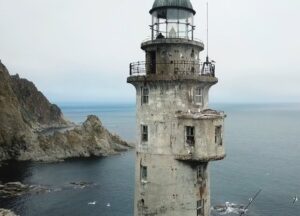 shipwreck, except for the lighthouse part, of course. Upon closer inspection, the lighthouse really doesn’t look like a ship at all, but maybe it was designed to give that illusion. The concrete tower, is painted to match the surrounding rocks, its stroboscopic lamp located 131 above the ground. The structure is round in shape and equipped with a bay window, the 9-floor tower stands on an oval base, which looks like it is coming out of the coastal rocks. Maybe that’s why it looks like a ship.
shipwreck, except for the lighthouse part, of course. Upon closer inspection, the lighthouse really doesn’t look like a ship at all, but maybe it was designed to give that illusion. The concrete tower, is painted to match the surrounding rocks, its stroboscopic lamp located 131 above the ground. The structure is round in shape and equipped with a bay window, the 9-floor tower stands on an oval base, which looks like it is coming out of the coastal rocks. Maybe that’s why it looks like a ship.
The Aniva Lighthouse was well equipped for living, no matter what the weather conditions. The basement was equipped with diesel engines and batteries. The kitchen was located on the ground floor along with the food storage The radio room, equipment room, and watch room were situated on the second floor of the lighthouse. As many as 12 people could be accommodated in the living quarters, located on the third, fourth and fifth floors, with each floor having a separate room. The interior of the quarters was modest, housing two bunk beds and small alcoves for personal belongings. Much of the light came in through small porthole windows. The storeroom was on the sixth floor. The seventh floor housed the mechanisms of a pneumatic siren, with its horn installed directly on the roof of the bay window. The eighth floor was used for fuel storage. The ninth floor housed the lens rotation mechanism of the lighthouse. The lantern rotated inside a bowl with about 660 pounds of mercury. The stroboscopic lamp was set in motion by a mechanism similar to a clockwork. Running through 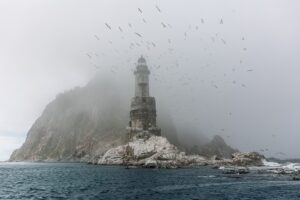 the center of a spiral staircase leading to the very top of the tower, was a pipe with a suspended weight of 595 pounds inside. It took the weight three hours to reach the bottom, rotating the lamp in the process. After that, the lighthouse keeper had to rewind the system. The lighthouse had a range of 17.5 miles. That must have been a job.
the center of a spiral staircase leading to the very top of the tower, was a pipe with a suspended weight of 595 pounds inside. It took the weight three hours to reach the bottom, rotating the lamp in the process. After that, the lighthouse keeper had to rewind the system. The lighthouse had a range of 17.5 miles. That must have been a job.
It was decided to make the Aniva Lighthouse autonomous by re-equipping it to work from a nuclear power source in the 1990s. In 2006, the radioisotope generators were removed. The lighthouse has been abandoned ever since. These days it is a haven for the birds.
 I liked Mathematics in school and I was pretty good at it, but I can’t say that I had the mind of a great mathematician. As to being able to invent something, or create something of great mathematical value, I don’t know if my mind worked in that direction. The really great inventions take an extraordinary mind…one like that of Gladys Mae West (née Brown), an American mathematician who was known for her contributions to the mathematical modeling of the shape of the Earth, and her work on the development of the satellite geodesy models that were eventually incorporated into the Global Positioning System (GPS). I doubt if anyone alive today can say they don’t know about GPS. It has been a fundamental part of life since 1973, although most of us knew nothing about it then.
I liked Mathematics in school and I was pretty good at it, but I can’t say that I had the mind of a great mathematician. As to being able to invent something, or create something of great mathematical value, I don’t know if my mind worked in that direction. The really great inventions take an extraordinary mind…one like that of Gladys Mae West (née Brown), an American mathematician who was known for her contributions to the mathematical modeling of the shape of the Earth, and her work on the development of the satellite geodesy models that were eventually incorporated into the Global Positioning System (GPS). I doubt if anyone alive today can say they don’t know about GPS. It has been a fundamental part of life since 1973, although most of us knew nothing about it then.
West was born in 1930 in Sutherland, Virginia, south of Richmond. Her family was an African-American farming family in a community of sharecroppers. Her mother worked at a tobacco factory, and her father was a farmer, who also worked for the railroad. West knew she did not want for follow in her parents’ footsteps, and she knew that the only way out was to get a really good education. Family money was not going to be her way to college, so she knew she would need scholarships. Fortunately, the high school she attended gifted the top two students each year with a full-ride scholarship to Virginia State College (University at that time), a historically black public university. West worked hard and graduated in 1948 with the title of valedictorian. With the goal of graduating as one of the top two students behind her, West was a little unsure of just what to do next. She had never given much thought to what she would study…if she got to go to college, but she really had her pick, because she had excelled in all of her courses. Her teachers and counselors encouraged her to major in science or math because of their difficulty. West chose to study mathematics, a normally male dominated subject at her college. She also became a member of the Alpha Kappa Alpha sorority. In 1952, she graduated with a Bachelor of Science in Mathematics. Following her graduation, West taught math and science at Waverly, Virginia for two years. Then returned to VSU to complete her Master of Mathematics degree. She graduated in 1955, and briefly took another teaching position in Martinsville, Virginia.
Her big break came in 1956 when she was hired to work at the Naval Proving Ground located in Dahlgren, Virginia. These days it’s called the Naval Surface Warfare Center. West started her job as the second black woman ever hired and one of only four black employees. West was a programmer in the Naval Surface Warfare Center Dahlgren Division for large-scale computers and a project manager for data-processing systems used in the analysis of satellite data. While she was working there, she was also in the process of earning a second master’s degree in public administration from the University of Oklahoma.
West was dedicated to her work. In the early 1960s, she participated in an award-winning astronomical study that proved the regularity of Pluto’s motion relative to Neptune. She also began to analyze data from satellites, putting together altimeter models of the Earth’s shape. She became project manager for the Seasat radar altimetry project, the first satellite that could remotely sense oceans. West consistently put in extra hours, cutting her team’s processing time in half. This extra time spent, earner her a commendation in 1979.
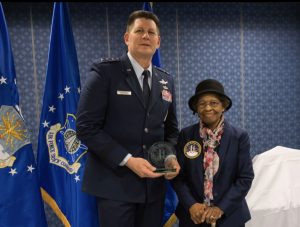
In the mid-1970s she began working on an IBM computer to deliver increasingly precise calculations to model the shape of the Earth…an ellipsoid with irregularities, known as the geoid. She generated an extremely accurate model which required her to employ complex algorithms to account for variations in gravitational, tidal, and other forces that distort Earth’s shape. West’s data ultimately became the basis for the Global Positioning System (GPS), which we all know about today. She was inducted into the United States Air Force Hall of Fame in 2018. Today, West lives quietly with her husband, Ira. They have 3 children and 7 grandchildren.
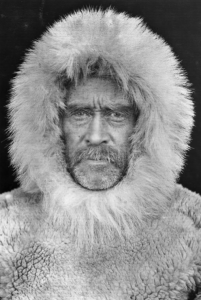
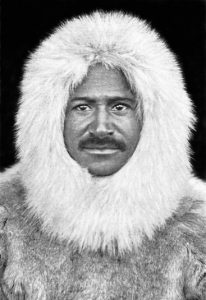 When I think of the world’s explorers, I think back to the 1500s to maybe the 1700s, but there are still explorers, and probably places that no man has ever been, and some explorations are still going on. That is most likely because some places are very difficult to reach. American explorer Robert Peary knew that all too well. Peary had a dream. He wanted to go to the North Pole. For many years one thing or another came between Peary and his dream, but finally on April 6, 1909, Peary and his assistant Matthew Henson, and four Eskimos reached what they determined to be the North Pole. I can only imagine how elated they felt. It was the journey of a lifetime for them.
When I think of the world’s explorers, I think back to the 1500s to maybe the 1700s, but there are still explorers, and probably places that no man has ever been, and some explorations are still going on. That is most likely because some places are very difficult to reach. American explorer Robert Peary knew that all too well. Peary had a dream. He wanted to go to the North Pole. For many years one thing or another came between Peary and his dream, but finally on April 6, 1909, Peary and his assistant Matthew Henson, and four Eskimos reached what they determined to be the North Pole. I can only imagine how elated they felt. It was the journey of a lifetime for them.
Peary, a US Navy civil engineer, made his first trip to the interior of Greenland in 1886. In 1891, Henson, a young African-American sailor, joined him on his second arctic expedition. Their team made an extended dogsled journey to the northeast of Greenland and explored what became known as “Peary Land.” Then, in 1893, they began working toward reaching the North Pole. In 1906, during their second attempt, they nearly reached latitude 88 degrees north, just 150 miles short of their objective. It would seem that they had the fever, because in 1908, they traveled to Ellesmere Island by ship and in 1909 raced across hundreds of miles of ice to reach what they calculated as latitude 90 degrees north on April 6, 1909. Although their achievement was widely acclaimed, Dr. Frederick A. Cook challenged their distinction of being the first to reach the North Pole. Cook, a former associate of Peary, claimed he had already reached the pole by dogsled the previous year. A major controversy followed, and in 1911 the US Congress formally recognized Peary’s claim over Cook’s.
Sadly, decades after Peary’s death, navigational errors in his travel log surfaced, placing the expedition in all probability a few miles short of its goal. I am glad he never knew. In recent years, further studies of the conflicting claims suggest that neither expedition reached the exact North Pole, but that Peary and Henson came far closer, falling perhaps just 30 miles short. On May 3, 1952, US Lieutenant Colonel Joseph O. Fletcher 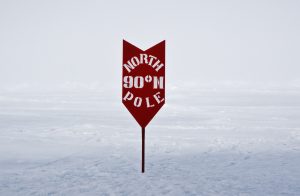
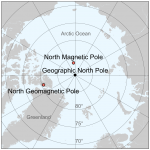 of Oklahoma stepped out of a plane and walked to the precise location of the North Pole, the first person to undisputedly do so. While he did step on the exact location, as confirmed by GPS or whatever measurement they used to confirm the location, it is my opinion that the accomplishment of Lieutenant Colonel Fletcher was nowhere near as amazing as that of Robert Peary and his team, who forged their way to the site, rather than being dropped on it.
of Oklahoma stepped out of a plane and walked to the precise location of the North Pole, the first person to undisputedly do so. While he did step on the exact location, as confirmed by GPS or whatever measurement they used to confirm the location, it is my opinion that the accomplishment of Lieutenant Colonel Fletcher was nowhere near as amazing as that of Robert Peary and his team, who forged their way to the site, rather than being dropped on it.
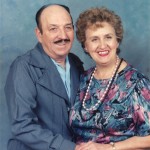 As we were going through our parents things after the passing of our mother, we came across several very old maps of different states, and also one that I received of London during World War II. It occurred to me that my sisters and I are a real novelty these days, in that we know how to read a map, and plan out a route to travel to anywhere we would like to go. I’m sure there are other people out there who can read maps too, but in this day and age of the GPS, many people can’t either. I’m all for technology, and I have a GPS myself, but I can also read a map, and that is because of my dad, and his determination to teach us that art.
As we were going through our parents things after the passing of our mother, we came across several very old maps of different states, and also one that I received of London during World War II. It occurred to me that my sisters and I are a real novelty these days, in that we know how to read a map, and plan out a route to travel to anywhere we would like to go. I’m sure there are other people out there who can read maps too, but in this day and age of the GPS, many people can’t either. I’m all for technology, and I have a GPS myself, but I can also read a map, and that is because of my dad, and his determination to teach us that art.
Every year our family would take a vacation. Sometimes we didn’t travel very far, like the year we took a Wyoming tour, in several separate legs over the course of two weeks. Other times, we traveled quite a ways, like the years we went to visit our sister, Cheryl Masterson, while she was living in upstate New York. As students go, we were a novelty too, because every year when the teacher asked the inevitable question about what we did over the summer, we always had a story to tell. At the time, we didn’t 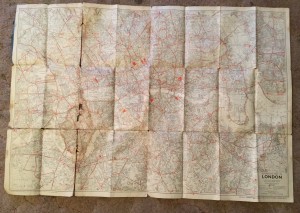 realize just how blessed…and how traveled we were, compared to other students in class. I always thought that everyone took a vacation, but that isn’t so. Many kids got to go visit a grandparent or some other relative, but going to the same place every summer isn’t really a vacation.
realize just how blessed…and how traveled we were, compared to other students in class. I always thought that everyone took a vacation, but that isn’t so. Many kids got to go visit a grandparent or some other relative, but going to the same place every summer isn’t really a vacation.
Our parents were so excited about our vacations every year, and we would often sit down and Dad would show us the route we were going to take on our trip. It was during these vacation planning sessions, that we learned to read a map, and that we learned to enjoy reading a map. The map was never confusing or complicated to us, because Dad showed us how to read it. We knew the difference between an interstate and a state highway. We knew how to pick out the larger cities, as opposed to the small towns. We knew what states and what towns we would be traveling through, and we knew how to find the sights that were located in the area that might be of interest. We knew how to find campgrounds in the area, and how to figure out how far we could easily travel in a days time. All these things are on a map, if you know where to look for them, and thanks to our dad, we did.

I suppose that many people wouldn’t think of a map as a treasure, but for my sisters and me, they really were. We all had to have some of them, and every time we look at them, they will serve as a reminder of those planning sessions, and of all those amazing vacations we took as kids, with our parents. I have no problem with the convenience of a GPS, and in the big cities my husband Bob and I travel to, they are a great help, but if my GPS ever failed, I could still get us there with a map. It is a legacy that our dad left for his daughters. It does make us a novelty, but it is something we are all proud to be able to do, and thankful that we had the parents we had. Their interest in travel, and Dad’s teachings on maps clearly enriched our lives.

